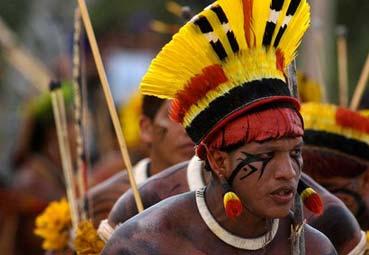That the bone didn't attract greater interest is more than a little puzzling, for its appearance came at a time when America was in a froth of excitement about the remains of large, ancient animals. The cause of this froth was a strange assertion by the great French naturalist the Comte de Buffon—he of the heated spheres from the previous chapter—that living things in the New World were inferior in nearly every way to those of the Old World.
骨頭沒有引起很大的興趣,這有點兒令人費解,因為發現這根骨頭恰好是在美國人對古代大動物的遺骸著迷的時候。偉大的法國博物學家布豐伯爵——就是前一章里提到的做加熱球體試驗的人——對這種著迷的原因作出了奇怪的斷言:新大陸的生物幾乎在哪一方面都要比舊大陸的生物低一等。

America, Buffon wrote in his vast and much-esteemed Histoire Naturelle, was a land where the water was stagnant, the soil unproductive, and the animals without size or vigor, their constitutions weakened by the "noxious vapors" that rose from its rotting swamps and sunless forests. In such an environment even the native Indians lacked virility. "They have no beard or body hair," Buffon sagely confided, "and no ardor for the female." Their reproductive organs were "small and feeble."
布豐在那部評價很高的巨著《自然史》里寫道,在美洲這塊土地上,水源發臭,土地不長五谷,動物個兒很小,缺乏活力,肌體被從腐爛的沼澤和曬不著太陽的森林里逸出的“毒氣”弄得十分虛弱。在這樣的環境里,連土著印第安人也缺乏生殖力。“他們不長胡子,身上也沒有毛,”布豐煞有介事地在私下說,“對女人沒有激情。”他們的生殖器“又小又沒有勁兒”。
Buffon's observations found surprisingly eager support among other writers, especially those whose conclusions were not complicated by actual familiarity with the country. A Dutchman named Comeille de Pauw announced in a popular work called Recherches Philosophiques sur les Americains that native American males were not only reproductively unimposing, but "so lacking in virility that they had milk in their breasts." Such views enjoyed an improbable durability and could be found repeated or echoed in European texts till near the end of the nineteenth century.
布豐的觀察結果在別的作家中間——尤其在那些其實對這個國家不大熟悉,因而自己的結論也是缺乏根據的人中間——獲得了出人意料的熱烈支持。有個名叫科梅耶·波夫的荷蘭人在一本名叫《關于美洲人的哲學研究》的通俗作品中宣稱,美洲的土著男人不但在繁殖方面給人印象不深,而且“如此缺乏生殖能力,他們的乳房都流著奶汁”。這種觀點奇怪地流行了很長時間,在歐洲的文獻中反復出現或得到反響,直到19世紀快要結束的時候。











